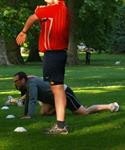 BUILD YOUR SKILLS TO WORK AS A PERSONAL TRAINER
BUILD YOUR SKILLS TO WORK AS A PERSONAL TRAINER
People come to work as a personal trainer via many different paths. Some move on from a career in fitness, health, sport or some related field; while others may take a course such as this to build on their own life experience and interest in personal fitness or sport. Most personal trainers are self employed; hence some skills (and perhaps flair) in business, will go a long way to helping you succeed.
This excellent course includes the Fitness Leaders Certificate as well as three core modules focusing on coaching, motivation, and industry experience. Students may then select three modules from our electives which include advanced aerobics, sports psychology, human anatomy, aquafitness, resistance & gym supervision and more.
Before embarking on this path, we strongly advise you to use our free course counseling service.
Modules
Note that each module in the Qualification - Advanced Certificate in Personal Training is a short course in its own right, and may be studied separately.
Know the Client Before Prescribing any Type of Exercise
The overall aim of fitness testing is to ensure someone follows the correct regime based on their health and limitations, to monitor their progress (or conversely their problems) all the way through the programme and to assist in the development of the fitness programme in relation to their changing physical needs. For example, once someone has improved their strength and aerobic fitness, more and differing repetition sequences could be introduced into their resistance training or a different treadmill ‘course’ could be suggested to encourage further fitness improvements.
Fitness tests may include assessment of body composition, cardiovascular health, muscular flexibility, muscular strength, and stamina and endurance testing. Speed and agility evaluations may be provided for individuals training for certain sports.
Also, and most importantly to many, regular body composition testing will allow for the tracking of changes in fat and muscle mass. Body composition testing can discriminate bodily changes much more effectively than weight alone. This may be of particular interest to those who are interested in monitoring fat loss as well as those interested in tracking muscular development.
Fitness testing should be regular throughout the course of your programme or ongoing throughout your life as fitness testing can objectively measure the effectiveness of your programme of exercise regimes. If progress is not significant, immediate changes may be made to a programme. A fitness coach or personal trainer should help someone to decide the tests which are most compatible for their fitness goals and how often they should be tested.
A fitness coach may redesign the programme or simply make a few suggestions for continued progress.
Informational handouts relating to exercise, nutrition, and wellness may also be made available. These services are a great way to enhance a current fitness programme or just get someone started on a new workout in a safe and effective manner. A fitness coach may encourage someone to get a comprehensive fitness tests performed every 3 to 6 months. Body composition tests may be performed more often; once every month or two; once every two weeks if significant dietary changes are made.
Assessing possible injury risks in fitness testing and creating tests that may indicate (or help to identify) factors which will be assessed is important. We suggest, the first thing to do is to list the factors to be evaluated and secondly to create an outline of the tests that may indicate and manage these elements.
It is important to make sure that the trainer is sufficiently educated in their role as observer and administrator of the test.
In summary, people may choose to participate in fitness testing for a variety of reasons:
- To determine their aerobic fitness in order to follow a worthwhile programme of training.
- To ensure any risk factors associated with their chosen form of exercise are identified.
- To evaluate competencies
- To identify limitations
- To determine body fat mass
- To determine existing body measurements for comparative purposes at a later stage
- For motivational purposes…once improvements on fitness, flexibility and strength are obtained, a person will feel motivate to continue the exercise regime on ‘seeing’ the results
Some fitness tests are designed to quickly gauge a person's general fitness level and to act as a benchmark for future testing. After taking the test, the idea is to follow through with a training program for a number of weeks. Then, take the test again and compare the results.
As it is sometimes difficult to do the test exactly as described, you just have to make sure you are consistent and do the exercise the same way each time. Then use the results as a benchmark for future testing. Usually the table of results is based on doing the tests a specific way, and will not always be accurate if the tests are modified at all.

When anyone is getting ready to take a test, take care of the following:
- Is it reproducible? Do not simply pace the distance on a speed test, you can not compare an indoor result with an outdoor result. For example: using calipers for skin fold measurements: let the same person do all the tests.
- Tell the people who are getting tested why they are tested, what the consequences of the outcome might be. Otherwise the results of the tests will be poor.
- Organise yourself (record keeping and so), publish the outcome of the test as quickly as possible. This motivates your clients as well as letting people know how they are doing.
- Take care in comparing results between clients.
- See if an experienced exercise physiologist can help you to interpret the results – if you are not familiar with the test or have any questions.
Why study this course?
More about what you study.
Most students will commence this course by studying the ACS Fitness
Leader Certificate. This course is a more extensive program than fitness
leader certificates offered in many other colleges; in particular,
because of it's more in depth study of human biology. This solid
grounding in anatomy and physiology allows you to understand issues of
health and wellbeing to a deeper level as you progress with other
modules.
For those who are interested, and wish to obtain additional
qualifications and recognition; we have established arrangements with
other colleges in both Australia and the UK which allow you, on
completion of this part of the course, to undertake a small amount of
additional study and assessment, to gain further certificates with those
colleges, and fitness leader registration in those countries.
Why study with ACS?
ACS follows the old fashioned idea that “the student comes first”.
Our staff are told to treat every student as an individual and respond
promptly to their enquiries; and the facilities we have developed and
continue to develop, are all focused on that goal.
